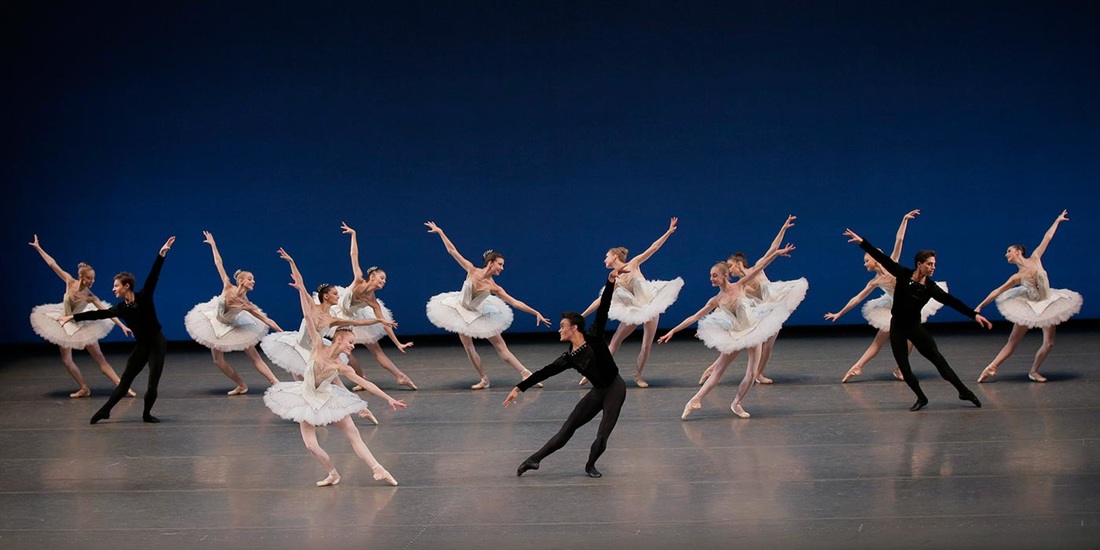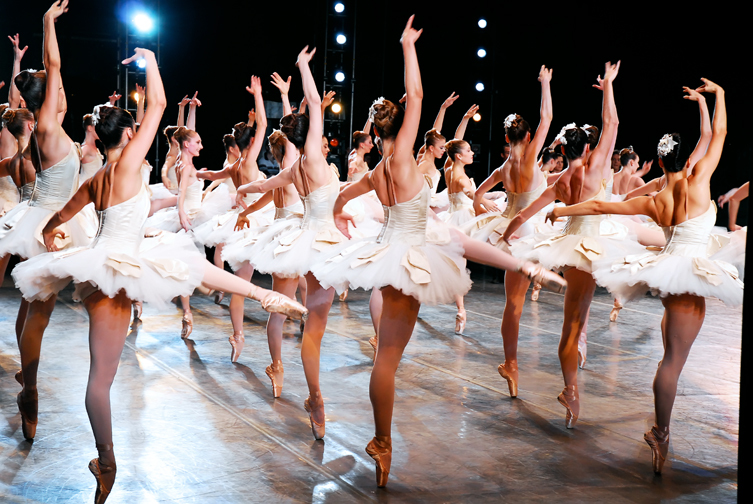I was dancing Balanchine’s Symphony in C all week. It closed an iconic Balanchine triple bill which began with Serenade followed by Agon. On opening night my regular partner Devin Alberda succumbed to illness right before the show, so I rehearsed with a brand new partner—the very game David Prottas—during Agon since David had to perform in Serenade as well. Poor David, who had never danced in Bizet (the dancer shorthand for Symphony in C) before, was flying blind that first show. But he did a great job of jumping right in. We ended up together for the entire week because by the time Devin recovered someone else was out, so he ended up changing spots too. It was quite the juggling act.
What happens to our tummies in DC I wonder? Last year we had a man throw up right before the Diamonds section of Balanchine’s Jewels. He vomited all over his glittery white tunic so there was no way someone could fill in for him since we didn’t have any extra costumes. We did an elaborate re-rigging of the finale in which couples were cut and demi-soloist men blended into the corps and then reemerged as demis again a step later. It was madness. I remember exiting during
It is a shame that we have been having such a difficult go of things in DC lately, because I very much enjoy performing there. My parents usually come down from Pittsburgh to see a show during our DC run, and this year was no different. They have fond memories of the many years they lived in DC while my dad wrote for the Legal Times and my mom attended George Washington University. My brothers and I were all born in nearby Arlington, Virginia and we lived in Alexandria during our early childhood. But even after my family moved away we visited DC almost every summer. I have such funny, formative memories from the city: like when I chipped my tooth in the swimming pool at the Omni Shoreham Hotel, or when my brother Sam licked the moon rock instead of touching it at the Air and Space Museum—which made everyone on line behind him very angry and made my mother panic about germs. At five years old Sam was quite the little epicure; he insisted that it tasted just like filet mignon.
But back to Bizet: I found it surprising that David had never danced the ballet even though he’s a senior corps member. But I guess for men it’s a ballet that takes quite a while to get into. Bizet uses 54 (ideally non-puking) dancers, and of that group only 12 are male. We often don’t have the requisite 42 women to dance the ballet so the corps of the second movement regularly doubles as the corps of the fourth. One can double first and third movements too. Young women are put into Bizet as soon as they join the company—the fourth movement is a training ground for newbies. I have danced in the first, second, and fourth movements over the years. (Third movement is for the tallest corps girls with small principals. Second movement, conversely, is for the smallest corps women and the tallest principals. It seems that the demis in all movements can be any height.) I always loved dancing the first movement, and the second movement is one of my favorite parts. It is so glamourous: the cold gray lighting makes it feel like a black and white movie, and the oboe solo is somehow mournful yet decadent. Everyone hates the fourth movement because it is so shot-out-of-a-cannon, and then one has to stand frozen on the side of the stage in B-plus for about ten minutes during the finale!
There is no male corps in Bizet; the male roles are either demi-soloist or principal parts so it can take a long time for guys to find their way into this signature ballet. I suppose the same goes for many of our iconic pieces: Agon, The 4 Temperaments, Symphony in Three Movements, Concerto Barocco, etc. Serenade is basically the same way except for two minutes of thankless and somewhat stressful partnering in the elegy section for four corps men who practically blend into the scenery in their blue unitards. They do not even bow. Poor shmucks: they are pejoratively nicknamed the “Blueberries.”
Even as long as I’ve been dancing Bizet, I still notice cool new things in the choreography all the time. As I waited in the wings for my finale entrance this time around, I noticed some truly amazing patterns in the first movement ladies’ finale steps. The men are offstage while the eight corps women are arrayed in opposing diagonals behind two demi-soloists with the principal woman on center. The corps is dancing boxed sets of piqué arabesque and piqué ballonné to the right and left—always falling off the foot on pointe, never rolling through it. The two groups mirror each other symmetrically and the demis do the same (but opposite to the group behind them) while the principal woman is doing piqué arabesque and piqué ballotté to the right and left in the center, rolling down through her pointe shoes every time. After two eights of music (or four sets of these fundamental exercises) the corps and the principal woman switch steps. The ballotté step follows the baseline of the music; the ballonné step mimics the score’s speedy top notes. Thus, Balanchine spends the first portion of the finale meticulously demonstrating the only two possible ways of getting off pointe (plié and tombé), but he does so in an intricate and highly musical way.
In my current role as a demi-soloist in the second movement I have noticed how Balanchine’s choreography exhibits every single way a man can support a woman in first arabesque: with both hands, both wrists, the front hand, the back hand, the waist. Most of these variations are applied to arabesque penché as well (save for front hand only—for they cannot get low enough, only the man lying on the floor in Agon achieves this grip in a ballet). But this classroom experimentation, to me, is the crux of the whole ballet: it consists of simple steps simply done—but the layering and interplay between groups of dancers as well as between the musical melodies and counterpoints form a work of awesome complexity.
The ballet opens with a sequence of tendus—the basic ballet barre step that is usually only employed as a warm-up for our feet. Balanchine begins and ends Symphony in C with tendus and in so doing elevates classroom vernacular to high art. The climax of Bizet’s finale consists of a ring of corps girls doing tendus to the downbeat around the stage while the principal women turn to the musical filigree in the middle. To make the tendu such a vibrant, showcase step—in lieu of a big jump or lift or kick, say—is practically unheard of! It is one of the greatest achievements in all of ballet. It is still my boyfriend’s absolute favorite piece of choreography, even after 14 years of watching it over and over again. Robert Garis, a dance writer I very much admire, closes his book Following Balanchine with a description of this moment:
And at the end of a particularly great performance of Symphony in C, when fifty dancers filled the stage with disciplined, free vitality, I felt an exhilarated happiness. My friends felt it too, we defined it in the same way, and we agreed about its value. When that exhilaration failed to come—for it did not come at every performance—we agreed about that too, for this happiness was too important to fake. It was one of the great things in our lives, and one of the great things in the century.




 RSS Feed
RSS Feed